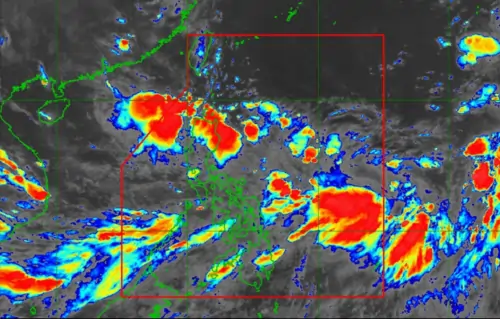
Signal No. 1 Alert for Northern Luzon: What to Expect from Gener
-ADVERTISEMENT-

Introduction
Signal No. 1 has been issued for several areas in Northern Luzon due to Typhoon Gener, a developing storm system that is anticipated to bring significant weather changes to the region.
This alert serves as a warning for residents to prepare for moderate winds and heavy rainfall, which could lead to disruptions and potential hazards.
Understanding the implications of Signal No. 1 and taking the necessary precautions are crucial for ensuring safety during this period of adverse weather.
Understanding Signal No. 1: What Does It Mean?
Signal No. 1 is a weather warning issued by the Philippine Atmospheric, Geophysical and Astronomical Services Administration (PAGASA) when a tropical cyclone is forecasted to bring wind speeds of 30 to 60 kilometers per hour (kph) within the next 36 hours. This signal indicates that residents in the affected areas should be prepared for potentially disruptive weather conditions. The key components of Signal No. 1 include:
- Winds: Moderate winds capable of causing minor damage.
- Rainfall: Heavy showers leading to possible flooding.
- Preparedness: Immediate action required to mitigate risks.
How Signal No. 1 Impacts Northern Luzon
The issuance of Signal No. 1 over Northern Luzon indicates that the region will start experiencing the effects of Typhoon Gener. The impact includes:
- Increased Wind Speeds: Potential for wind gusts that can damage structures and vegetation.
- Heavy Rainfall: Risk of flooding in low-lying areas and possible landslides in mountainous regions.
- Disruption of Activities: Possible interruptions in daily routines and transportation.
Overview of the Storm ‘Gener’
Storm ‘Gener’ Overview
Typhoon Gener is currently moving through the Pacific and is predicted to intensify as it approaches the Philippines. The storm features a well-defined center and a broad circulation system that could bring severe weather conditions to Northern Luzon.
A Brief History of Typhoon Gener
Typhoon Gener, named by PAGASA, follows a history of significant storms impacting the Philippines. Previous storms with similar naming conventions have been associated with substantial rainfall, strong winds, and widespread flooding.
Current Path and Forecast for ‘Gener’
The current forecast indicates that Typhoon Gener will continue moving northwest, potentially shifting its path due to varying atmospheric conditions. Meteorologists are closely monitoring its trajectory to provide accurate forecasts and warnings.
Potential Strength and Impacts of the Storm
Gener is expected to strengthen into a Category 1 or 2 typhoon, bringing:
- Sustained Winds: Up to 60 kph, which can cause structural damage.
- Heavy Rainfall: Leading to potential flooding and landslides.
- Power Disruptions: Possible outages due to strong winds.
Geographical Impact on Northern Luzon
Regions Affected by Signal No. 1
Signal No. 1 has been issued for several key regions in Northern Luzon, including:
- Ilocos Region: Coastal areas may experience rough seas and potential storm surges.
- Cagayan Valley: Agricultural lands could face disruptions and crop damage.
- Cordillera Administrative Region: Risk of landslides and road blockages due to mountainous terrain.
Detailed Impact on Key Northern Luzon Areas
Here’s a detailed look at the impact on specific areas:
| Region | Potential Impacts |
|---|---|
| Ilocos Region | Coastal flooding, storm surges, and rough seas. |
| Cagayan Valley | Crop damage, flooding in low-lying areas. |
| Cordillera Region | Landslides, road blockages, and infrastructure damage. |
Weather Conditions to Expect
Expected Weather Patterns and Changes
Residents should expect a progression of weather patterns including:
- Initial Calm: Periods of relative calm before intense weather conditions.
- Heavy Rainfall: Increased rain showers and thunderstorms.
- Strong Winds: Gradual increase in wind speeds leading up to peak conditions.
Rainfall and Wind Speed Predictions
Forecasts predict:
- Rainfall: 50 to 100 millimeters, with higher amounts in localized areas.
- Wind Speeds: Up to 60 kph, with stronger gusts in exposed locations.
Safety Precautions and Preparedness
Essential Safety Measures During Signal No. 1
Residents should implement the following safety measures:
- Home Reinforcement: Secure windows and doors, and reinforce structural components.
- Emergency Kit: Prepare a kit with food, water, medications, and first aid supplies.
- Secure Valuables: Protect important documents and valuables in a secure location.
Emergency Preparedness Checklist
- Verify Structural Safety: Ensure that your home is fortified against strong winds.
- Assemble Emergency Supplies: Include food, water, and essential items in your emergency kit.
- Document Storage: Secure important documents and keep them dry.
- Stay Informed: Monitor weather updates and heed evacuation orders if issued.
- Family Communication: Establish a plan to stay in touch with family members.
ADVERTISEMENT-

Government and Local Authority Actions
Updates from PAGASA and Local Weather Stations
PAGASA and local weather stations are providing ongoing updates about Typhoon Gener. These updates include:
- Storm Path: Current and predicted path of the storm.
- Weather Alerts: Changes in weather conditions and alerts.
- Safety Recommendations: Guidelines for preparing and staying safe.
Actions Taken by Local Government Units
Local government units are responding with:
- Evacuation Centers: Setting up shelters for those in vulnerable areas.
- Disaster Response: Coordinating with emergency services for quick response.
- Information Dissemination: Providing updates and safety information to residents.
Community Response and Updates
How Communities Are Preparing
Communities are taking proactive measures such as:
- Relief Distribution: Organizing the distribution of essential supplies.
- Shelter Arrangements: Setting up temporary shelters and providing assistance.
- Safety Drills: Conducting drills to prepare residents for potential emergencies.
Real-Time Updates and Information Sources
For real-time updates:
- Official Channels: Follow PAGASA’s website and social media accounts.
- Local News: Tune in to local news broadcasts for the latest information.
- Community Alerts: Check community bulletin boards and local announcements.
Potential Long-Term Effects
Possible Impact on Agriculture and Infrastructure
Long-term effects may include:
- Agricultural Damage: Potential loss of crops and disruption to farming.
- Infrastructure Repair: Need for repairs to roads, bridges, and utilities.
Long-Term Weather Patterns and Future Forecasts
Post-storm forecasts will help:
- Assess Damage: Evaluate the extent of damage and recovery needs.
- Predict Patterns: Analyze any changes in weather patterns that could affect future seasons.
Historical Context of Similar Storms
Comparisons with Past Typhoons in Northern Luzon
Reviewing past typhoons provides context:
- Similar Storms: Compare Gener to previous typhoons in terms of intensity and impact.
- Historical Data: Use past data to anticipate possible outcomes.
Lessons Learned from Previous Storms
Insights from previous storms include:
- Preparedness: Importance of timely evacuation and safety measures.
- Response Efficiency: Enhancing disaster response based on past experiences.
Resources and Support
Where to Find Help and Resources
Resources include:
- Local Government Offices: For assistance and information.
- Disaster Response Organizations: For emergency aid and support.
- Community Support Groups: For additional help and resources.
Contact Information for Emergency Services and Support
For immediate assistance:
- NDRRMC: Contact for national disaster response information.
- Local Police and Fire Departments: For emergency services.
- Medical Facilities: For health-related emergencies and support.
Read More about the PAGASA: Signal No. 1 in parts of Luzon as Gener hastens approach
Disclaimer
The information provided in this article is based on current forecasts and data available from PAGASA and other reliable sources. Weather conditions can change rapidly, and it is essential to stay updated through official channels and local authorities. The accuracy of predictions and forecasts may vary, so always follow the advice of emergency services and local officials.
User Reviews
“I appreciate the detailed breakdown of the storm’s impact and the safety measures recommended. It’s reassuring to have such thorough information to prepare for Typhoon Gener. The real-time update section is particularly useful.” Lorna M.
“The article provided clear and actionable advice on how to handle the storm. The emphasis on emergency preparedness and the comparison with past typhoons helped me understand what to expect and how to stay safe.” Daisy D.
Conclusion
Signal No. 1 has been issued for Northern Luzon due to Typhoon Gener, highlighting the need for preparedness against moderate winds and heavy rainfall. By understanding the storm’s potential impact, implementing safety measures, and staying informed through reliable sources, residents can better manage the challenges posed by this weather event.
Effective preparation and community cooperation are key to navigating the effects of Typhoon Gener and ensuring the safety and well-being of all affected individuals.
Frequently Asked Questions
What is Signal No. 1 and how does it affect me?
Signal No. 1 is a weather warning indicating that a tropical cyclone is expected to bring winds of 30 to 60 kph within the next 36 hours. It affects residents by signaling the need to prepare for potential wind damage, flooding, and disruptions.
How can I prepare for Typhoon Gener?
To prepare for Typhoon Gener, secure your home, prepare an emergency kit with essentials, and stay informed through official updates. Ensure that you have a plan for communication and evacuation if necessary.
What areas are under Signal No. 1?
Signal No. 1 has been issued for several regions in Northern Luzon, including the Ilocos Region, Cagayan Valley, and the Cordillera Administrative Region. Check local advisories for specific affected areas.
What should I do if I experience flooding or power outages?
If you experience flooding, move to higher ground and avoid driving through floodwaters. For power outages, use battery-operated lights and conserve food in the refrigerator. Report outages to your utility provider and follow local safety instructions.
How can I stay updated on the storm’s progress?
Stay updated by following official weather updates from PAGASA, local news broadcasts, and community alerts. Ensure that you have access to reliable sources of information throughout the duration of the storm.
Related Links

Rihanna Cruz, is a wordsmith seasoned in three years of online gaming journalism, captivates readers with her passion-fueled articles. She translates complex mechanics into engaging narratives, offering insightful perspectives on mobile RPGs, esports psychology, and more.








